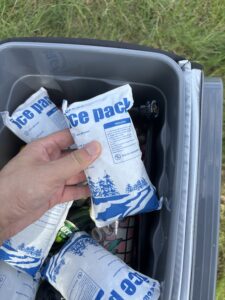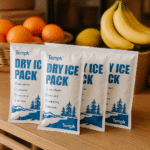Shipping fresh seafood requires precise temperature control to maintain quality and prevent spoilage. Fish box dry ice packs are a crucial component of this process, ensuring that seafood remains at its optimal temperature throughout the journey. Dans ce guide, we’ll discuss how dry ice packs work, leurs avantages, meilleures pratiques pour une utilisation, and how to keep your shipments compliant with regulations. Whether you’re shipping for short or long distances, understanding dry ice’s role can greatly improve your cold chain logistics.
-
What are the key benefits of using fish box dry ice packs for seafood shipping?
-
How do dry ice packs maintain optimal freshness during transit?
-
What should you consider when choosing the right dry ice pack for seafood shipments?
-
What are the latest trends in fish box dry ice shipping?
What are the key benefits of using fish box dry ice packs for seafood shipping?
Fish box dry ice packs offer numerous advantages over other cooling methods, especially when shipping delicate seafood products. Here’s why they’re considered the best option for cold chain logistics:
1. Contrôle de température optimal
Dry ice sublimates at -78.5°C (-109.3°F), providing the extremely cold environment necessary to keep seafood frozen during extended transit. This ensures that fish remains at the ideal temperature, reducing spoilage and bacterial growth that can occur when the temperature fluctuates above freezing.
2. Efficiency in Weight and Space
Unlike traditional gel or water-based ice packs, dry ice packs are much lighter. This reduction in weight lowers shipping costs and optimizes packaging efficiency, allowing for more cost-effective shipping of seafood without compromising quality.
3. No Residue or Mess
One of the biggest concerns with traditional ice is the risk of water leakage, which can damage the packaging and compromise the seafood. Dry ice avoids this issue by sublimating directly into gas, leaving no liquid behind to cause potential damage.
| Avantage | Description | Practical Implications |
|---|---|---|
| Contrôle de la température | Keeps seafood frozen | Prevents spoilage and maintains freshness |
| Efficient Weight | Lighter than traditional ice | Reduces shipping costs and improves efficiency |
| Pas de résidu | Sublimates into gas without liquid residue | Protects the packaging and contents from water damage |
How do fish box dry ice packs maintain optimal freshness during transport?
Dry ice plays a critical role in the preservation of seafood by maintaining ultra-low temperatures for extended periods. Here’s how dry ice works to keep your seafood fresh:
Instant Cooling and Long-Lasting Effect
When placed inside a fish box, dry ice begins cooling immediately. It can last for 24 à 72 heures, Selon la quantité utilisée, box insulation, et températures externes. Dans certains cas, with proper insulation and dry ice placement, the cooling duration can extend up to 144 heures, making it ideal for long-distance or international seafood shipments.
Glace sèche vs. Méthodes de refroidissement traditionnelles
Traditional ice packs or gel packs are unable to maintain such low temperatures for extended durations. While gel packs maintain temperatures between 2°C and 8°C pour 12 à 24 heures, dry ice consistently maintains temperatures far below freezing, which is crucial for frozen seafood.
| Méthode de refroidissement | Plage de température | Durée | Meilleure utilisation | Sens pratique |
|---|---|---|---|---|
| Paquet de glace sec | -78.5°C (-109.3°F) | 24–72 heures (up to 144h) | Long-distance frozen seafood | Ideal for extended shipping periods |
| Pack de gel | 0–8 ° C (32–46 ° F) | 6–24 heures | Chilled seafood or short shipments | Moderate cooling, réutilisable |
| Paquet de glace à l'eau | 0°C (32°F) | 6–8 heures | Short trips or non-perishable items | Melts quickly, causes potential damage |
What should you consider when selecting a dry ice pack for seafood shipping?
Choosing the right dry ice pack is essential for ensuring that your seafood arrives fresh and safe. Consider the following factors when selecting dry ice for fish box shipping:
1. Shipment Duration and Dry Ice Quantity
Pour les expéditions plus longues, you’ll need more dry ice to keep the seafood frozen. Calculate the dry ice required based on the shipment’s duration and the type of seafood. Par exemple, shipping seafood for 48 heures avec high insulation typically requires 6 livres de glace carbonique par 20 lbs of seafood.
2. Box Size and Insulation Quality
The size and insulation of your fish box directly impact the cooling duration. High-quality boxes made from HDPE et mousse de polyuréthane are essential for reducing sublimation rates and ensuring that the dry ice lasts longer.
3. Conformité réglementaire
Ensure that your shipping method adheres to Et 1845 Classe 9 règlements. This includes proper labeling, documentation, and packaging that allow CO₂ gas to escape safely and prevent hazardous pressure buildup inside the packaging.
| Facteur | Consideration | Pourquoi ça compte |
|---|---|---|
| Durée de l'expédition | Choose the right amount of dry ice | Prevents thawing and maintains seafood freshness |
| Box Size & Isolation | Use insulated materials | Extends cooling duration and minimizes dry ice usage |
| Conformité réglementaire | Ensure labeling and packaging | Adheres to legal requirements and ensures safety |
What are the latest trends in fish box dry ice shipping?
As the demand for fresh seafood grows globally, innovations in cold chain logistics are becoming more prominent. Some key trends include:
1. Sustainability and Eco-friendly Solutions
Many companies are now focusing on reducing their environmental footprint by adopting sustainable packaging materials, biodegradable dry ice, and more efficient logistics systems. Reusable insulated boxes are also gaining popularity as they lower waste and reduce overall shipping costs.
2. Smart Monitoring and IoT Integration
Avec capteurs intelligents embedded in dry ice packaging, real-time temperature tracking is now more accessible than ever. These IoT-based solutions ensure better monitoring, allowing shippers to detect temperature excursions and reduce the risk of spoilage.
3. Systèmes de refroidissement hybrides
Some companies are combining dry ice with Matériaux à changement de phase (PCMS) ou packs de gel to extend cooling times while reducing the amount of dry ice used. This hybrid system is more cost-effective and environmentally friendly.
| S'orienter | Description | Impact on Seafood Shipping |
|---|---|---|
| Durabilité | Use of biodegradable and eco-friendly materials | Reduces packaging waste and CO2 emissions |
| Intégration IoT | Real-time temperature tracking systems | Ensures better quality control and reduces loss |
| Systèmes de refroidissement hybrides | Combination of dry ice and PCMs/gel packs | Extends cooling duration while reducing dry ice usage |
Questions fréquemment posées (FAQ)
Q1: Combien de temps dure la glace sèche pendant l'expédition?
La glace sèche peut durer n'importe où 24 à 72 heures depending on factors like insulation, the quantity used, and ambient temperatures.
Q2: Can I ship seafood without dry ice?
For short distances or chilled seafood, packs de gel ou Matériaux à changement de phase (PCMS) may be a suitable alternative. Cependant, dry ice is essential for keeping seafood frozen for longer periods.
Q3: Are there regulations for shipping seafood with dry ice?
Oui, shipping with dry ice requires proper Et 1845 labeling and documentation to comply with international regulations.
Conclusion et recommandations
En résumé, fish box dry ice packs are the most effective solution for shipping fresh seafood, especially when it comes to maintaining ultra-low temperatures for long durations. By understanding the science behind dry ice and following best practices, you can ensure your seafood reaches its destination in pristine condition.
Étapes suivantes:
-
Consult with professionals to determine the right dry ice solution for your shipments.
-
Invest in high-quality insulated boxes to ensure maximum cooling efficiency and product safety.
-
Stay updated on the latest trends and regulations in cold chain logistics to remain compliant and competitive.
À propos du tempk
Et tempk, we specialize in providing state-of-the-art dry ice solutions for the seafood industry, ensuring your shipments remain fresh, sûr, and compliant with all regulations. Our commitment to quality and sustainability sets us apart. Contact us today to learn how we can optimize your cold chain logistics with our expert dry ice solutions.
























